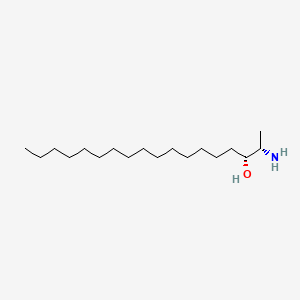| Authors | Title | Published | Journal | PubMed Link |
|---|---|---|---|---|
| Chen BS et al. | Diastereoselective synthesis and bioactivity of long-chain anti-2-amino-3-alkanols. | 2011 | Eur J Med Chem | pmid:21955681 |
| Sánchez AM et al. | Spisulosine (ES-285) induces prostate tumor PC-3 and LNCaP cell death by de novo synthesis of ceramide and PKCzeta activation. | 2008 | Eur. J. Pharmacol. | pmid:18343365 |
| Rotthier A et al. | Characterization of two mutations in the SPTLC1 subunit of serine palmitoyltransferase associated with hereditary sensory and autonomic neuropathy type I. | 2011 | Hum. Mutat. | pmid:21618344 |
| Massard C et al. | Phase I dose-escalating study of ES-285 given as a three-hour intravenous infusion every three weeks in patients with advanced malignant solid tumors. | 2012 | Invest New Drugs | pmid:22215532 |
| Vilar E et al. | A phase I dose-escalating study of ES-285, a marine sphingolipid-derived compound, with repeat dose administration in patients with advanced solid tumors. | 2012 | Invest New Drugs | pmid:20820909 |
| den Brok MW et al. | Development and validation of a liquid chromatography-ultraviolet absorbance detection assay using derivatisation for the novel marine anticancer agent ES-285 x HCl [(2S,3R)-2-amino-3-octadecanol hydrochloride] and its pharmaceutical dosage form. | 2003 | J Chromatogr A | pmid:14661748 |
| Stokvis E et al. | Quantitative analysis of ES-285, an investigational marine anticancer drug, in human, mouse, rat, and dog plasma using coupled liquid chromatography and tandem mass spectrometry. | 2003 | J Mass Spectrom | pmid:12794877 |
| Duan J and Merrill AH | 1-Deoxysphingolipids Encountered Exogenously and Made de Novo: Dangerous Mysteries inside an Enigma. | 2015 | J. Biol. Chem. | pmid:25947379 |
| Esaki K et al. | L-Serine Deficiency Elicits Intracellular Accumulation of Cytotoxic Deoxysphingolipids and Lipid Body Formation. | 2015 | J. Biol. Chem. | pmid:25903138 |
| Maraschiello C et al. | Phenylisothiocyanate and dansyl chloride precolumn derivatizations for the high-performance liquid chromatography analysis of the antitumoral agent ES-285 in dog plasma. | 2003 | J. Chromatogr. B Analyt. Technol. Biomed. Life Sci. | pmid:12798159 |
Spisulosine
Spisulosine is a lipid of Sphingolipids (SP) class. Spisulosine is associated with abnormalities such as Infection, Renal impairment and Lesion of brain. The involved functions are known as Gene Expression, Cell Cycle, Drug Kinetics, Signal Transduction and Cell Cycle Arrest. Spisulosine often locates in Body tissue, Microfilaments, Skin, Stress Fibers and Tissue specimen.
Cross Reference
Introduction
To understand associated biological information of Spisulosine, we collected biological information of abnormalities, associated pathways, cellular/molecular locations, biological functions, related genes/proteins, lipids and common seen animal/experimental models with organized paragraphs from literatures.
What diseases are associated with Spisulosine?
Spisulosine is suspected in Infection, Renal impairment, Lesion of brain and other diseases in descending order of the highest number of associated sentences.
Related references are mostly published in these journals:
| Disease | Cross reference | Weighted score | Related literature |
|---|
No disease MeSH terms mapped to the current reference collection.
PubChem Associated disorders and diseases
What pathways are associated with Spisulosine
There are no associated biomedical information in the current reference collection.
PubChem Biomolecular Interactions and Pathways
Link to PubChem Biomolecular Interactions and PathwaysWhat cellular locations are associated with Spisulosine?
Visualization in cellular structure
Associated locations are in red color. Not associated locations are in black.
Related references are published most in these journals:
| Location | Cross reference | Weighted score | Related literatures |
|---|
What functions are associated with Spisulosine?
Related references are published most in these journals:
| Function | Cross reference | Weighted score | Related literatures |
|---|
What lipids are associated with Spisulosine?
There are no associated biomedical information in the current reference collection.
What genes are associated with Spisulosine?
There are no associated biomedical information in the current reference collection.
What common seen animal models are associated with Spisulosine?
There are no associated biomedical information in the current reference collection.
